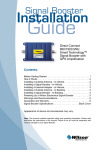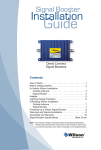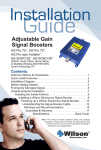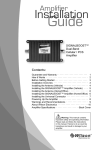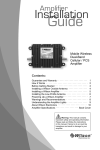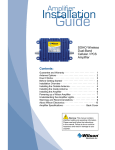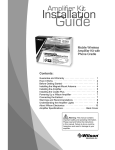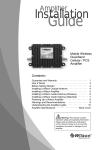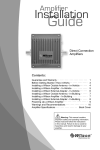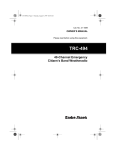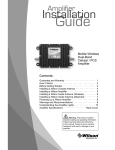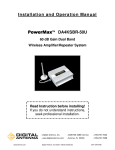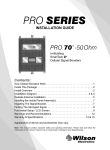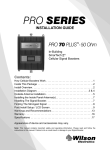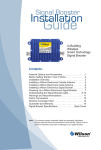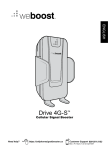Download Installation - wpsantennas.com
Transcript
Amplifier Installation Guide Dual-Band Direct Connection Amplifier with GPS Contents: Guarantee and Warranty · · · · · · · · · · · · · · · · · · · · · · · · 1 Before Getting Started / How it Works · · · · · · · · · · · · · · 3 Installing a Wilson Outside Antenna - In-Vehicle · · · · · · 4 Installing a Wilson Amplifier - In-Vehicle · · · · · · · · · · · · 5 Installing a Wilson External Adapter - In-Vehicle · · · · · · 6 Installing a Wilson Outside Antenna - In-Building · · · · · 7 Installing a Wilson Amplifier - In-Building · · · · · · · · · · · · 7 Installing a Wilson External Adapter - In-Building · · · · · 8 Powering Up a Wilson Amplifier · · · · · · · · · · · · · · · · · · · 9 Warnings and Recommendations · · · · · · · · · · · · · · · · · 10 Amplifier Specifications · · · · · · · · · · · · · · · · · Back Cover ! Warning: This manual contains important safety and operating information. Please read and follow the instructions in this manual. Failure to do so could be hazardous and result in damage to your amplifier. Wilson ® Electronics, Inc. www.wpsantennas.com 1-877-594-5766 [email protected] 30-Day Money-Back Guarantee All Wilson Electronics products are protected by Wilson’s 30-day money-back guarantee. If for any reason the performance of any product is not acceptable, simply return the product directly to the reseller with a dated proof of purchase. 1-Year Warranty Wilson Electronics amplifiers are warranted for one (1) year against defects in workmanship and / or materials. Warranty cases may be resolved by returning the product directly to the reseller with a dated proof of purchase. Amplifiers may also be returned directly to the manufacturer at the consumer’s expense, with a dated proof of purchase and a Returned Material Authorization (RMA) number supplied by Wilson Electronics. Wilson shall, at its option, either repair or replace the product. Wilson Electronics will pay for delivery of the repaired or replaced product back to the original consumer. This warranty does not apply to any amplifiers determined by Wilson Electronics to have been subjected to misuse, abuse, neglect, or mishandling that alters or damages physical or electronic properties. RMA numbers may be obtained by phoning Technical Support at 877-594-5766. The Manufacturer’s rated output power of this equipment is for single carrier operation. Operation is subject to the following two conditions: (1) This device may not cause interference, and (2) this device must accept any interference, including interference that may cause undesired operation of this device. Disclaimer: The information provided by Wilson Electronics, Inc. is believed to be complete and accurate. However, no responsibility is assumed by Wilson Electronics, Inc. for any business or personal losses arising from its use, or for any infringements of patents or other rights of third parties that may result from its use. Copyright © 2007 Wilson Electronics, Inc. All rights reserved. www.wpsantennas.com 1-877-594-5766 [email protected] Installation Instructions for the Following Wilson Amplifiers Direct Connection Dual-Band Amplifier with GPS – Model # 2B1401 - Part #811200 Contains 1575 MHz bypass to allow for GPS reception. FCC ID: PWO2B1401SA IC: 4726A-2B1401SA The term “IC” before the radio certification number only signifies that Industry Canada technical specifications were met. Antenna Options and Accessories 800 MHz Yagi Cellular Antenna Amplifier Soft Cases 1900 MHz Yagi PCS Antenna Amplifier Hard Kit Cases 800 MHz Yagi Cellular Antenna Mini Magnet Dual-Band Magnet Mount Dual-Band Trucker Mount Dual-Band Marine Antenna Dual-Band NMO Mount Dual-Band www.wpsantennas.com 1-877-594-5766 [email protected] Before Getting Started This guide will help you properly install Wilson’s direct connection amplifiers in both invehicle and in-building applications. It is important to read through all of the installation steps for your particular application prior to installing any equipment. Read through the instructions, visualize where all the equipment will need to be installed and do a soft installation before mounting any equipment. If you do not understand the instructions in full, seek professional help, or contact Wilson Technical Support at 877-594-5766. Inside this Package • Direct connection amplifier • DC plug-in power supply with On/Off switch • 6 ‘ extension cable Direct connection amplifier DC plug-in power supply 6‘ extension cable Additional Equipment • Outside antenna for in-vehicle or in-building use (required) (NOTE: specifically tuned iDEN antennas available) • Cell phone-specific external antenna adapter (required) • AC/DC power supply (optional – for in-building use) How it Works Wilson amplifiers are small, portable, bi-directional devices that deliver service levels consistent with what would be expected in areas of high cell network coverage. They amplify a weak or shadowed signal in mobile, marine and in-building applications. When using a Wilson amplifier in conjunction with Wilson antennas, the outside antenna will collect the cell tower signal and send it through the cable to the amplifier. Cell phones and cellular data cards (laptops) then communicate with the improved signal. When a cell phone or cellular data card transmits, the signal is amplified by the amplifier and broadcast back to the cell tower through the outside antenna. www.wpsantennas.com 1-877-594-5766 [email protected] In-Vehicle Installing a Wilson Outside Antenna To receive the best cell signal, select a location in the center of the vehicle’s roof at least 12 inches away from any other antennas and free of obstructions. Follow the specific antenna installation instructions included with the outside antenna (sold separately). The outside antenna must be installed vertically. Signal performance will be degraded if the antenna is not vertical. Optional MagnetMount Antenna Shown The antenna cable may be run through the door to the amplifier. NOTE: See RF Safety Warnings (p. 10) Carefully Pull Down Door Seal Run Cable Under Seal For a more professional-looking installation, the antenna cable may be run under the door seal. Carefully pull down the door seal. Run the cable through the seal and push the seal back into place. This prevents constant wear and tear on the cable as the door opens and closes. The antenna cable is small enough to easily tuck under the door seal or plastic molding. Tuck Cable Under Seal www.wpsantennas.com 1-877-594-5766 [email protected] In-Vehicle Installing a Wilson Amplifier Select a location to install the amplifier that is away from excessive heat, direct sunlight, moisture and that has proper ventilation. Recommended installation locations for in-vehicle are: • Under the seat • In the trunk • Under the dash Run the cable from the outside antenna and attach it to the FME-Male connector labeled “outside antenna” on the amplifier. Outside Antenna ! Warning: Do not plug in the DC power supply until the outside antenna and external adapter cables are attached to the amplifier. Cell Phone DC Power Supply Amplifier www.wpsantennas.com 1-877-594-5766 [email protected] In-Vehicle Installing a Wilson External Adapter An 18-inch external adapter is required to connect the cell phone or cellular data card to the amplifier. The external adapter is cell phone/data card-specific and may be purchased through a local retailer. Sample adapter Refer to Wilson’s Adapter Guide to identify the right adapter for your cell phone or cellular data card. The adapter guide is available through a local retailer or visit www.wilsonelectronics.com. The external adapter plugs into the included antenna extension cable and directly into a socket on the cell phone or cellular data card as shown in Figure 1. The external adapter and the included extension cable are long enough to reach the amplifier location. This allows for ease and convenience of use. Run the extension cable from the external adapter and attach it to the FME-Male connector labeled “cellular phone” on the amplifier. NOTE: Depending on your specific cell phone, the adapter socket may be located beneath a rubber plug. Figure 1 www.wpsantennas.com 1-877-594-5766 [email protected] In-Building Installing a Wilson Outside Antenna – In-Building Select a location on the roof of the building to install the outside antenna that has the most unobstructed line of sight to the cell tower. Follow the specific antenna installation instructions included with the outside antenna. Lightning protection is recommended for all in-building installations. Take extreme care to ensure neither you nor the antenna come in contact with any electrical power lines. A Yagi antenna must be installed horizontally with the elements vertical and the drip hole on the bottom. Ensure there are three feet of clearance in all directions surrounding the antenna. To obtain maximum performance, the antenna should point toward the cell tower. Follow the instructions included with the outside antenna. Installing a Wilson Amplifier Select a location to install the amplifier that is away from excessive heat, direct sunlight, moisture and that has proper ventilation. Ensure the amplifier is installed within six feet RF Signal Cell Tower Yagi External Antenna NOTE: See RF Safety Warnings (p. 10) of where the cell phone or cellular data card will be used (to accommodate the six-foot adapter extension cable). Run the cable from the outside antenna and attach it to the FME-Male connector labeled “outside antenna” on the amplifier. Connect the AC/DC power supply (sold separately) to the power input labeled “DC 12 V IN” on the amplifier. Recommended installation locations for in-building are: • On a wall • On the ceiling • Near a power outlet www.wpsantennas.com 1-877-594-5766 [email protected] In-Building Installing a Wilson External Adapter An 18-inch external adapter is required to connect the cell phone or cellular data card to the amplifier. The external adapter is cell phone/data card-specific and may be purchased through a local retailer. Refer to Wilson’s Adapter Guide to identify the right adapter for your cell phone or cellular data card. The adapter guide is available through a local retailer or visit www.wilsonelectronics.com. Sample adapter The external adapter plugs into the included six-foot extension cable and directly into a socket on the cell phone or cellular data card as shown in Figure 1 on page 6. (NOTE: See the user’s manual for your specific phone or data card to determine the socket location.) Run the extension cable from the external adapter on the cell phone or cellular data card and attach it to the FME-Male connector labeled “cellular phone” on the amplifier. Extension Cable Chart The following Wilson extension cables are available to help you customize your installation for peak performance. 951101 5’ Extension Cable RG58U Low Loss Coax 0.6 dB loss 951102 10’ Extension Cable RG58U Low Loss Coax 1.2 dB loss 951103 15’ Extension Cable RG58U Low Loss Coax 1.8 dB loss 951104 20’ Extension Cable RG58U Low Loss Coax 2.4 dB loss, N-Male to FME-Female 951108 20’ Extension Cable 9913 Equivalent Ultra Low Loss Coax Only use 9913 Equivalent Low Loss Coax for extensions 20’ or longer, 0.8 dB loss 951105 30’ Extension Cable 9913 Equivalent Ultra Low Loss Coax 1.2 dB loss 951106 50’ Extension Cable 9913 Equivalent Ultra Low Loss Coax 2.0 dB loss 951117 75’ Extension 9913 Equivalent Ultra Low Loss Coax 3.0 dB loss 951107 100’ Extension 9913 Equivalent Ultra Low Loss Coax 4.0 dB loss 951113 2’ Extension 9913 Equivalent Ultra Low Loss Coax (N-Male to N-Male Ends) 0.08 dB loss, Jumper Coax - Can be used to connect a splitter behind an amplifier. 951110 2’ Extension RG58U Low Loss Coax (N-Male to FME-Female) Used with the Yagi antenna to help find the optimum signal strength (for installation purposes only). RG58U - FME connectors / 9913 - N connectors www.wpsantennas.com 1-877-594-5766 [email protected] Powering up a Wilson Amplifier ! Warning: Verify that both the outside antenna and the adapter extension cable are connected to the amplifier before powering up the amplifier. For in-vehicle, first connect the power cable to the amplifier input marked “DC 12 V IN” and then insert the large end into a 12 V DC power socket or cigarette lighter outlet. Carefully insert the power cable. The amplifier may remain on all the time; however, leaving the amplifier on in a vehicle when it is not running can discharge the battery in a day or two. A good option is to power the amplifier through the ignition switch so that the amplifier turns off and on with the vehicle. In-vehicle 12-volt DC power supply (included) For in-building, first connect the optional AC/DC power supply to the amplifier input labeled “DC 12 V IN” and then into a wall outlet. ! Warning: Use only a Wilson power supply. Use of a non-Wilson product could damage your equipment. In-building AC/DC power supply (optional) Testing a Wilson Amplifier To test your amplifier, go to a weak signal area where your cell phone registers only 1-2 bars without the amplifier turned on. Then, connect the amplifier to the phone and you should see a signal improvement of 2 or more bars. Note: many phones take up to 20 seconds to reset the bar indicator. www.wpsantennas.com 1-877-594-5766 [email protected] Warnings and Recommendations Warning: Verify that both the outside antenna and the adapter extension cable are connected to the amplifier before powering up the amplifier. Warning: RF Safety: In-vehicle - The outside antenna must be installed with a separation of at least 20 inches from any of the vehicle’s occupants or nearby persons and must not be located or operating in conjunction with any other antenna or amplifier. Use of a cellular amplifier with an antenna gain higher than 6.12 dBi is in violation of FCC regulations, for which the offender is fully liable. All Wilson mobile antennas are 6.12 dBi or less. Warning: RF Safety: In-vehicle - All roof-mount antennas should be centrally located on the roof of the vehicle. Glass-mount antennas should be located in the middle of either the front or back windshield. Mirror-mount antennas should be at least six feet from the ground and at least 20 inches from any persons in or around the vehicle. Warning: RF Safety: In-Building - The outside antenna must be installed on an outdoor permanent structure with a separation of at least 26 inches from all persons during normal operation. The outside building antenna must not have a gain that exceeds 15 dBi. All Wilson outside building antennas have gains of 15 dBi or less. Lightning protection is recommended for all in-building installations. NOTE: The aluminum casing of a Wilson amplifier will adjust very quickly to the ambient temperature of its environment. For example, in the summer, when the inside of a car can reach 140 degrees Fahrenheit, the amplifier temperature may be 150 degrees or higher. The casing will be hot to the touch, similar to a metal door handle or a steering wheel. Such high temperatures will not damage the amplifier, nor do they pose a fire risk to the vehicle. As recommended in these instructions, install the amplifier in a location with adequate ventilation, such as under the seat, in the trunk or under the dashboard. Keep the area free of items that could block air flow to the amplifier. 10 www.wpsantennas.com 1-877-594-5766 [email protected] Amplifier Specifications Dual Band 800/1900 MHz Specifications Model Number / Part Number Connectors Impedance (input/output) Dimensions Weight Frequency 1 Passband Gain (nominal) 2B1401 / 811200 FME-Male 50 ohms 5 x 3.5 x 1.2 inch or 12.7 x 8.9 x 3 cm 1.03 lbs or 0.468 kg 824-894 MHz / 1850-1990 MHz / 1575 MHz 800 MHz and 1900 MHz 1575 MHz 2 3 20 dB 8 dB 20 dB Bandwidth (nominal) 800 MHz (uplink/downlink) 1900 MHz (uplink/downlink) Power output for single cell phone (uplink) CDMA GSM EDGE WCDMA Power output for single received channel (downlink) 3 800 MHz 33 dBm 32.6 dBm 33.1 dBm 33.5 dBm 1900 MHz 29.6 dBm 27.3 dBm 27.8 dBm 29.7 dBm 800 MHz CDMA GSM EDGE AMPS GPS Power output for multiple received channels (downlink). The maximum power is reduced by the number of channels: 50 MHz / 49 MHz 121 MHz / 94 MHz 1575 MHz 9.7 dBm 8.7 dBm 9.1 dBm 10.3 dBm 1900 MHz 13.6 dBm 9.6 dBm 12.3 dBm 11.9 dBm 18 dBm 4 Noise Figure (typical) Isolation Power Requirements Amplifier Usage Maximum Power Number of channels 2 3 4 5 6 800 MHz 1900 MHz 10.1 dBm 6.5 dBm 4.0 dBm 2.1 dBm 0.5 dBm 10.9 dBm 7.4 dBm 4.9 dBm 2.9 dBm 1.4 dBm 3 dB nominal > 90 dB 12 V, .5 A - 1.5 A (subject to uplink power) Notes: 1. Nominal gain is the maximum gain at any frequency in the passband. 2. Nominal bandwidth is the difference between two frequencies that are adjacent to the passband where the amplification is 20 dB lower than the passband amplification. One of the frequencies is lower than the passband and the other is higher. 3. The Manufacturer’s rated output power of this equipment is for single carrier operation. For situations when multiple carrier signals are present, the rating would have to be reduced by 3.5 dB, especially where the output signal is reradiated and can cause interference to adjacent band users. This power reduction is to be by means of input power or gain reduction and not by an attenuator at the output of the device. 4. The maximum power for 2 or more simultaneous signals will be reduced by 6 dB every time the number of signals is doubled. Phone: 877-594-5766 www.wpsantennas.com Wilson® Electronics, Inc. www.WPSANTENNAS.com 1-877-594-5766 Fax: 866-827-4052 [email protected] Part #110662 DC with GPS Bypass / 07.15.08












